Murray River
| Murray River | |
|---|---|
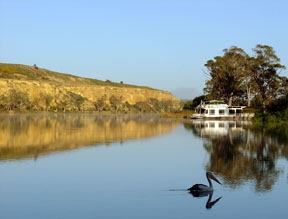 |
|
| Origin | Australian Alps |
| Mouth | Goolwa, South Australia |
| Basin countries | Australia |
| Length | 2,575 km (1,600 mi) |
| Avg. discharge | 767 m³/s (27,100 cu ft/s) |
| Basin area | 1,061,469 km2 (409,835 sq mi) |
The Murray River, or River Murray and sometimes informally referred to as the "Mighty Murray", is Australia's largest river. At 2,575 kilometres (1,600 miles) in length, the Murray rises in the Australian Alps, draining the western side of Australia's highest mountains and, for most of its length, meanders across Australia's inland plains, forming the border between New South Wales and Victoria as it flows to the northwest, before turning south for its final 500 kilometres (310 mi) or so into South Australia then ends at the mouth at Lake Alexandrina.
The waters of the Murray flow through several lakes that fluctuate in salinity (and were often fresh until recent decades) including Lake Alexandrina and The Coorong before emptying through the Murray Mouth into the southeastern portion of the Indian Ocean, often referenced on Australian maps as the Southern Ocean, near Goolwa.[1] Despite discharging considerable volumes of water at times, particularly before the advent of large scale river regulation, the Mouth has always been comparatively small and shallow.
Contents |
Geography
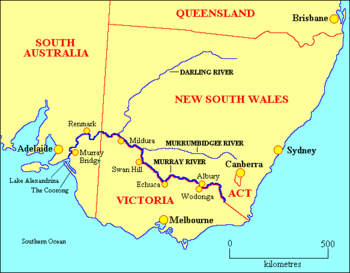
The Murray River forms part of the 3,750 kilometre (2,300 miles) long combined Murray-Darling river system which drains most of inland Victoria, New South Wales, and southern Queensland. Overall the catchment area is one seventh of Australia's land mass. The Murray carries only a small fraction of the water of comparably-sized rivers in other parts of the world, and with a great annual variability of its flow. In its natural state it has even been known to dry up completely in extreme drought, although that is extremely rare, with only two or three instances of this occurring since official record keeping began.
The Murray makes up much of the border of the Australian states of Victoria and New South Wales. The border is generally agreed upon to be the southern high water mark of the river (ie, none of the river itself is actually in Victoria). This boundary definition can be ambiguous, as the river has changed its course slightly since the boundary was defined in 1851.
West of the 141°E line of longitude, the river continues as the Victoria - South Australia border for 3.6 kilometres (2.2 mi), this being the only stretch where a state border runs down the middle of the river. This was due to a miscalculation in the 1840s when the border was originally surveyed. Past this point, the Murray River is entirely within the state of South Australia.
River life
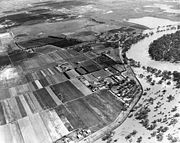
The Murray River (and associated tributaries) support a variety of unique river life adapted to its vagaries. This includes a variety of native fish such as the famous Murray cod, trout cod, golden perch, Macquarie perch, silver perch, eel-tailed catfish, Australian smelt and western carp gudgeon, to name a few, and other aquatic species like the Murray short-necked turtle, Murray River crayfish, broad-clawed yabbies and the large clawed Macrobrachium shrimp, as well as aquatic species more widely distributed through south-eastern Australia such as common long-necked turtles, common yabbies, the small claw-less Parataya shrimp, water rats and Platypus. The Murray River also supports fringing corridors and forests of the famous river red gum.
The health of the Murray River has declined significantly since European settlement, particularly due to river regulation, and much of its aquatic life including native fish are now declining, rare or endangered. Recent extreme droughts (2000–2007) have put significant stress on river red gum forests, with mounting concern over their long term survival. The Murray has also flooded on occasion, the most significant of which was the 1956 flood which inundated many towns on the lower Murray and lasted for up to six months.
Introduced fish species such as Carp, Gambusia, weather loach, redfin perch and brown trout and rainbow trout have also had serious negative effects on native fish, while Carp have contributed to environmental degradation of the Murray River and tributaries by destroying aquatic plants and permanently raising turbidity. In some segments of the Murray, carp have been the only species found.
Ancient history
Lake Bungunia
Between 2.5 and 0.5 million years ago the Murray River terminated in a vast freshwater lake called Lake Bungunia. Lake Bungunia was formed by earth movement that blocked the Murray River near Swan Reach during this period of time. At its maximum extent Lake Bungunia covered 33,000 square kilometres (13,000 sq mi), extending to near the Menindee Lakes in the north and to near Boundary Bend on the Murray in south.[2] The draining of Lake Bungunia approximately 0.5 million years ago must have been a dramatic event. Deep clays deposited by the lake are evident in cliffs around Chowilla in South Australia. Considerably higher rainfall would have been required to keep such a lake full; the draining of Lake Bungunia appears to mark the end of a wet phase in the history of the Murray-Darling Basin and the onset of widespread arid conditions similar to today. A species of Neoceratodus lungfish existed in Lake Bungunia (McKay & Eastburn, 1990); today Neoceratodus lungfish are only found in several Queensland rivers.
Cadell Fault and formation of the Barmah Red Gum Forests
The famous Barmah Red Gum Forests owe their existence to the Cadell Fault. About 25,000 years BP, displacement occurred along the Cadell fault, raising the eastern edge of the fault (which runs north-south) 8-12 metres above the floodplain. This created a complex series of events. A section of the original Murray River channel immediately behind the fault was abandoned, and exists today as an empty channel known as Green Gully. The Goulburn River was dammed by the southern end of the fault to create a natural lake. The Murray River flowed to the north around the Cadell Fault, creating the channel of the Edward River which exists today and through which much of the Murray River's waters still flow. Then the natural dam on the Goulburn River failed, the lake drained, and the Murray River avulsed to the south and started to flow through the smaller Goulburn River channel, creating "The Barmah Choke" and "The Narrows" (where the river channel is unusually narrow), before entering into the proper Murray River channel again.
This complex series of events however divert attention from the primary result of the Cadell Fault. The primary result of the Cadell Fault is that the west-flowing water of the Murray River strikes the north-south running fault and diverts both north and south around the fault in the two main channels (Edward and ancestral Goulburn) as well as a fan of small streams, and regularly floods a large amount of low-lying country in the area. These conditions are perfect for River Red Gums, which rapidly formed forests in the area. Thus the displacement of the Cadell Fault 25,000 BP lead directly to the formation of the famous Barmah River Red Gum Forests
The Barmah Choke and The Narrows mean the amount of water that can travel down this part of the Murray River is restricted. In times of flood and high irrigation flows the majority of the water, in addition to flooding the Red Gum forests, actually travels through the Edward River channel. The Murray River has not had enough flow power to naturally enlarge The Barmah Choke and The Narrows to increase the amount of water they can carry.
The town of Barmah, Victoria is unusual in that it is north of part of New South Wales, although everywhere else Victoria is south of New South Wales. Echuca on the map above is very close to Barmah.
The Cadell Fault is quite noticeable as a continuous, low, earthen embankment as one drives into Barmah from the west, although to the untrained eye it may appear man-made.

Murray Mouth
The Murray Mouth is the point at which the Murray River empties into the sea.[1] Since the early 2000s, dredging machines have operated at the Murray Mouth, moving sand from the channel to maintain a minimal flow from the sea and into the Coorong's lagoon system. Without the 24 hour dredging, the Mouth would silt up and close, cutting the supply of fresh sea-water into the Coorong, which would then warm up, stagnate and die.
Mythology
Being one of the major river systems in one of the driest continents of Earth, the Murray has significant cultural relevance to Indigenous Australians. According to the peoples of Lake Alexandrina, the Murray was created by the tracks of the Great Ancestor, Ngurunderi, as he pursued Pondi, the Murray Cod. The chase originated in the interior of New South Wales. Ngurunderi pursued the fish (who, like many totem animals in Aboriginal myths, is often portrayed as a man) on rafts (or lala) made from red gums and continually launched spears at his target. But Pondi was a wily prey and carved a weaving path, carving out the river's various tributaries. Ngurundi was forced to beach his rafts, and often create new ones as he changed from reach to reach of the river.
At Kobathatang, Ngurunderi finally got lucky, and struck Pondi in the tail with a spear. However, the shock to the fish was so great it launched him forward in a straight line to a place called Peindjalang, near Tailem Bend. Eager to rectify his failure to catch his prey, the hunter and his two wives (sometimes the escaped sibling wives of Waku and Kanu) hurried on, and took positions high on the cliff on which Tailem Bend now stands. They sprung an ambush on Pondi only to fail again. Ngurunderi set off in pursuit again, but lost his prey as Pondi dived into Lake Alexandrina. Ngurunderi and his women settled on the shore, only to suffer bad luck with fishing, being plagued by a water fiend known as Muldjewangk. They later moved to a more suitable spot at the site of present-day Ashville. The twin summits of Mount Misery are supposed to be the remnants of his rafts, they are known as Lalangengall or the two watercraft.
Remarkably, this story of a hunter pursuing a Murray cod that carved out the Murray persists in numerous forms in various language groups that inhabit the enormous area spanned by the Murray system. The Wotojobaluk people of Victoria tell of Totyerguil from the area now known as Swan Hill who ran out of spears while chasing Otchtout the cod.
European Exploration
The first Europeans to explore the river were Hamilton Hume and William Hovell, who crossed the river where Albury now stands in 1824: Hume named it the Hume River after his father. In 1830 Captain Charles Sturt reached the river after travelling down its tributary the Murrumbidgee River and named it the Murray River in honour of the then British Secretary of State for War and the Colonies Sir George Murray, not realising it was the same river that Hume and Hovell had encountered further upstream. Sturt continued down the remaining length of the Murray to finally reach Lake Alexandrina and the river's mouth. The area of the Murray Mouth was explored more thoroughly by Captain Collet Barker in 1831. In 1852 Francis Cadell built a canoe and set off to become the first European to travel the whole length of the river.
In 1858 the Government Zoologist, William Blandowski, along with Gerard Krefft, explored the lower reaches of the Murray and Darling rivers, compiling a list of birds and mammals. During the expedition they accumulated 17,400 specimens and described several new species.
River transport
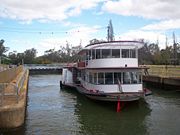
The lack of an estuary means that shipping cannot enter the Murray from the sea. However in the 19th century the river used to support a substantial commercial trade using shallow-draft steamboats, the first trips being made by two boats from South Australia on the spring flood of 1853. One vessel, Lady Augusta reached Swan Hill while another, Mary Ann made it as far as Moama (near Echuca). In 1855 a steamer carrying gold-mining supplies reached Albury but Echuca was the usual turn-around point though small boats continued to link with up-river ports such as Tocumwal, Wahgunya and Albury[3].
The arrival of steamboat transport was welcomed by pastoralists who had been suffering from a shortage of transport due to the demands of the gold fields. By 1860 a dozen steamers were operating in the high water season along the Murray and its tributaries. Once the railway reached Echuca in 1864, the bulk of the woolclip from the Riverina was transported via river to Echuca and then south to Melbourne. The Murray was plagued by "snags", fallen trees submerged in the water, and considerable efforts were made to clear the river of these threats to shipping by using barges equipped with steam-driven winches. In recent times, efforts have been made to restore many of these "snags" by placing dead gum trees back into the river. The primary purpose of this is to provide habitat for fish species whose breeding grounds and shelter were eradicated by the removal of "snags".

The volume and value of river trade made Echuca Victoria's second port and in the decade from 1874 it underwent considerable expansion. By this time up to thirty steamers and a similar number of barges were working the river in season. River transport began to decline once the railways touched the Murray at numerous points. The unreliable levels made it impossible for boats to compete with the rail and later road transport. However, the river still carries pleasure boats along its entire length.
Today, most traffic on the river is recreational. Small private boats are used for water skiing and fishing. Houseboats are common, both commercial for hire and privately owned. There are a number of both historic paddle steamers and newer boats offering cruises ranging from a half-hour to 5 days.
River crossings
The Murray River has been a significant barrier to land-based travel and trade. Many of the ports for transport of goods along the Murray have also developed as places to cross the river, either by bridge or ferry.
Water storage and irrigation

Small-scale pumping plants began drawing water from the Murray in the 1850s and the first large-volume plant was constructed at Mildura in 1887. The introduction of pumping stations along the river promoted an expansion of farming and led ultimately to the development of irrigation areas (including the Murrumbidgee Irrigation Area). In 1915 the three Murray states — New South Wales, Victoria and South Australia — signed the River Murray Agreement which proposed the construction of storage reservoirs in the river's headwaters as well as at Lake Victoria near the South Australian border. Along the intervening stretch of the river a series of locks and weirs were built. These were originally proposed to support navigation even in times of low water, but river-borne transport was already declining due to improved road and rail systems.
In 2006 the state government of South Australia revealed their plan to investigate the construction of the controversial Wellington Weir.
Locks
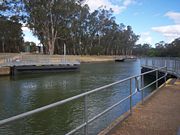
Lock 1 was completed near Blanchetown in 1922. Torrumbarry Weir downstream of Echuca began operating in December 1923. Of the numerous locks that were proposed, only thirteen were completed; Locks 1 to 11 on the stretch downstream of Mildura, Lock 15 at Euston and Lock 26 at Torrumbarry. Construction of the remaining weirs purely for navigation purposes was abandoned in 1934. The last lock to be completed was Lock 15, in 1937. Lock 11, just downstream of Mildura, creates a 100-kilometre (62 mi) long lock pool which aided irrigation pumping from Mildura and Red Cliffs. Each lock has a navigable passage next to it through the weir, which is opened during periods of high river flow, when there is too much water for the lock. The weirs can be completely removed, and the locks completely covered by water during flood conditions. Lock 11 is unique in that the lock was built inside a bend of the river, with the weir in the bend itself. A Channel was dug to the lock, creating an island between it and the weir. The weir is also of a different design, being dragged out of the river during high flow, rather than lifted out.
Four large reservoirs were built along the Murray; in addition to Lake Victoria (completed late 1920s) is Lake Hume near Albury-Wodonga (completed 1936), Lake Mulwala at Yarrawonga (completed 1939) and Lake Dartmouth, which is actually on the Mitta Mitta River upstream of Lake Hume (completed 1979). The Murray also receives water from the complex dam and pipeline system of the Snowy Mountains Scheme.

These dams inverted the patterns of the river's natural flow from the original winter-spring flood and summer-autumn dry to the present low level through winter and higher during summer. These changes ensured the availability of water for irrigation and made the Murray Valley Australia's most productive agricultural region, but have seriously disrupted the life cycles of many ecosystems both inside and outside the river, and the irrigation has led to dryland salinity that now threatens the agricultural industries.
The disruption of the river's natural flow, run-off from agriculture, and the introduction of pest species like the European Carp has led to serious environmental damage along the river's length and to concerns that the river will be unusably salty in the medium to long term — a serious problem given that the Murray supplies 40% of Adelaide's domestic water. Efforts to alleviate the problems proceed but disagreement between interested groups stalls progress.
See also
|
Major tributaries
|
Population centres
|
External links
- The Murray Darling Crisis - ABC TV Catalyst
- Murray-Darling Basin Commission: The River Murray and Lower Darling
- River pilot maps 1880-1918 / Echuca Historical Society
- Down the River Murray An ABC 5 part series on the river and its people
- SouthAustralia.com Murraylands - Travel Guides, Accommodation, Tours, Online Booking, Maps etc
- Murray Outback - Guide to the major towns on the Murray and Murray Outback Region.
Notes and references
- ↑ 1.0 1.1 "The Murray Mouth". Murray-Darling Basin Commission. Retrieved on 2007-09-20.
- ↑ "How The River Murray Was Formed". River Murray Urban Users Committee. Retrieved on 2006-11-20.
- ↑ Railways and Riverboats Rowland, E.C. Australian Railway Historical Society Bulletin, January, 1976 pp1-16
- Isaacs J (1980) Australian Dreaming: 40,000 Years of Aboriginal History, Lansdowne Press, Sydney, New South Wales, ISBN 0-7018-1330-X
- Norman Mackay and David Eastburn (editors), ed. (1990). The Murray. Canberra, Australia: Murray-Darling Basin Commission. ISBN 1-875209-05-0.